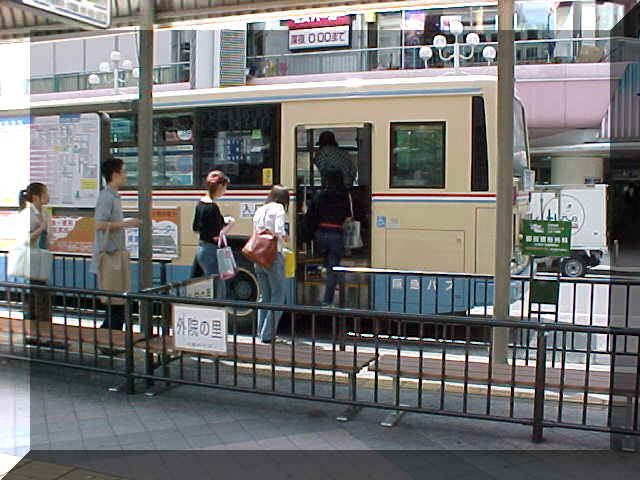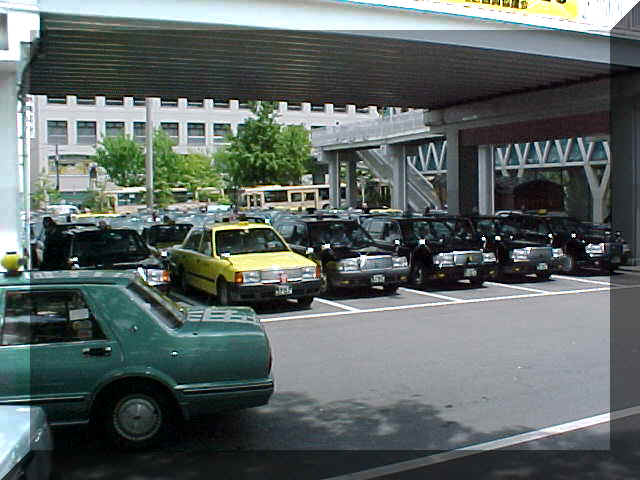 |
TRAVEL AND TRANSPORTATION
TRAVELING
Before embarking on any expedition, you should plan your trip. Consult subway, train and/or road maps to make sure that you are clear on how to reach your destination. All the subways in Osaka are colour coded and very easy to use. Most subways will link you to a JR or private train line. Larger scale road maps are available in English.
HOW TO CATCH…
TRAINS.
All train stations have ticket machines and a map. Find your destination on the map, and then buy a ticket for the appropriate amount from a machine. The cost of the ticket is listed under the station name, and the child’s fare is usually listed underneath. (Children U/12 are half price. Up to two children U/6 can travel for free with a paying adult.) If you are in doubt, guess a lesser amount for your ticket. At your destination, put your ticket into the Fare Adjustment machine and pay the balance. EASY. Otherwise you can buy a prepaid Rainbow card (or equivalent) at the ticket machine, which takes all the guessing out of it. A variety of discount tickets are also available at special offices in major stations.
The gate machine does not return single tickets that you purchase at the start of your trip when you exit a station. Other multiple ride cards will continue to be returned until the initial purchase cost has been exhausted.
**ALWAYS check the times of the last train of the day. Times vary for weekdays, weekends and public holidays.
There are two major train stations in the area that can be accessed by the No. 78 bus from school. The Hankyu Line is located at Kita Senri, and the Midosuji Line at Senri Chuo. Both these lines travel into the city. The monorail system also has stations at Yamada (on the Hankyu Line), and at Senri Chuo.
 |
BUSES.
Once you’ve decided which bus you are going to take, you must enter via the rear door. If a small white ticket is issued from the machine just inside the door, take it. This ticket states the section number in which you embarked. To stop the bus, just push one of the ‘next stop’ buttons, and pay the fare on the way out of the bus. Now, how much will the fare be? The fares are all listed on the electronic board at the front of the bus. As you travel further, and cross through sections, the electronic board will be automatically updated. If you have a white section ticket, a number will be printed on it. Match your ticket number with the corresponding fare amount stated on the electronic board. If you didn’t receive a ticket, then you must pay the full or most expensive fare.
On departing the bus, you must pay your fare with the exact money. The machine by the driver has the facility to change 500-yen coins and 1000 yen notes. If you need change, you should do this during your trip so as not to hold up people trying to exit the bus at the same time as you.
Children U/12 travel for half price. One child U/6 may travel for free with a paying adult.
**Once again, make sure that you familiarize yourself with the bus times.
|
|
 |
TAXIS.
Hailing a taxi on the street is simple. A green or blue light in the front window of the taxi means that it is occupied. A red light means that it is free to take passengers.
If you need to order a taxi by phone, you will need to provide the following information in Japanese. Speak slowly and clearly. Wait for the taxi company operator to confirm that they have understood each step. This is usually done by them saying the word hai, or ‘yes’ in Japanese.
1. Sumimasen. I’m sorry.
Nihongo wa dekimasen. I don’t understand Japanese.
2. Watashi wa _____________ desu. My name is ___________.
3. Watashi no jusho wa __________________ desu. My address is ____________.
4. Watashi no denwa bango wa ____________ desu. My telephone number is ____________.
5. _______________ ni ikitai desu. I want to go to ________________.
_______________ no chikaku desu. It’s near ______________ (give a local landmark that’s nearest your house or chome).
6. The taxi company may ask Nan ji desu ka? What time?
You may reply: Ima (now)
Kyo (today) Give a time.
Ashita (tomorrow) Give a time. Gozen is a.m. and gogo is p.m.
Once you have registered with a particular taxi company, the next time you make a booking you only need provide your telephone number in Japanese (your home details will be on file), and then your destination etc.
**This information is also transferable when ordering takeaway etc.